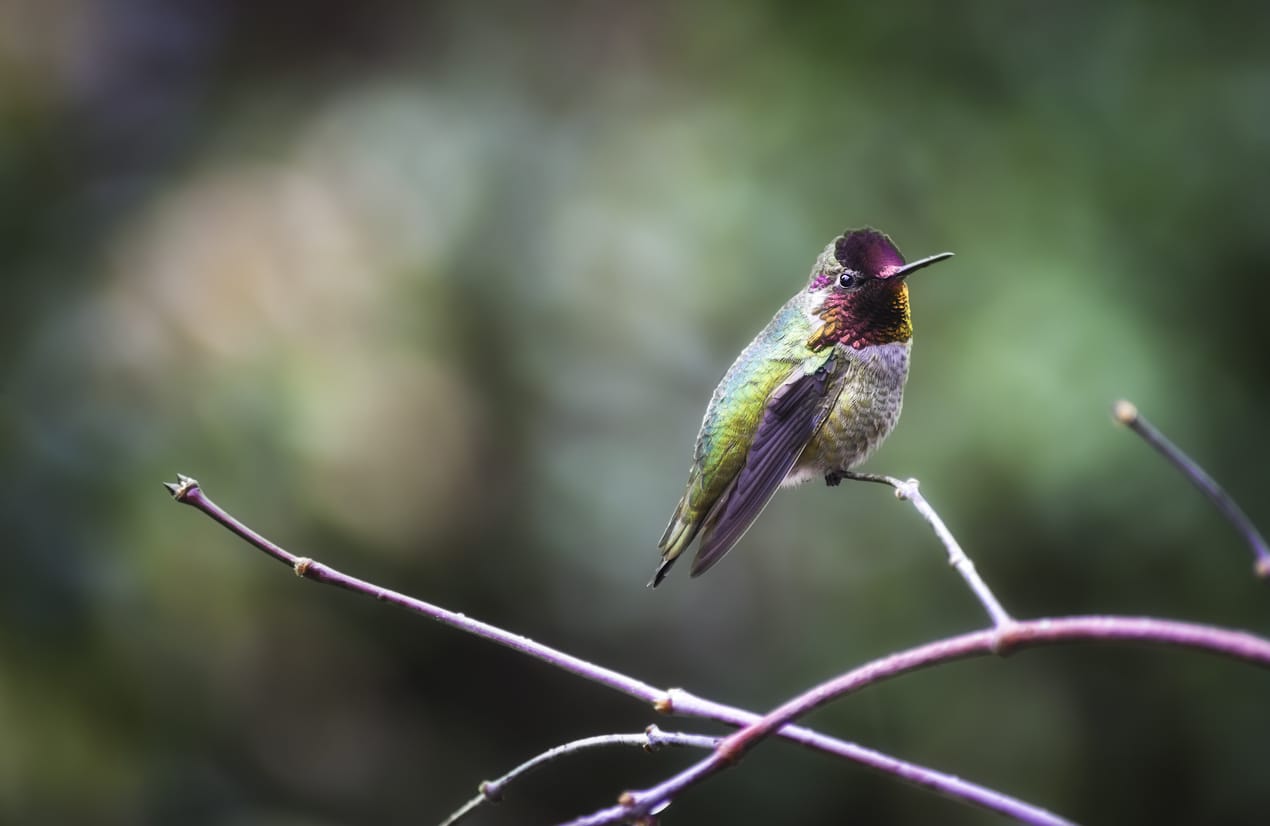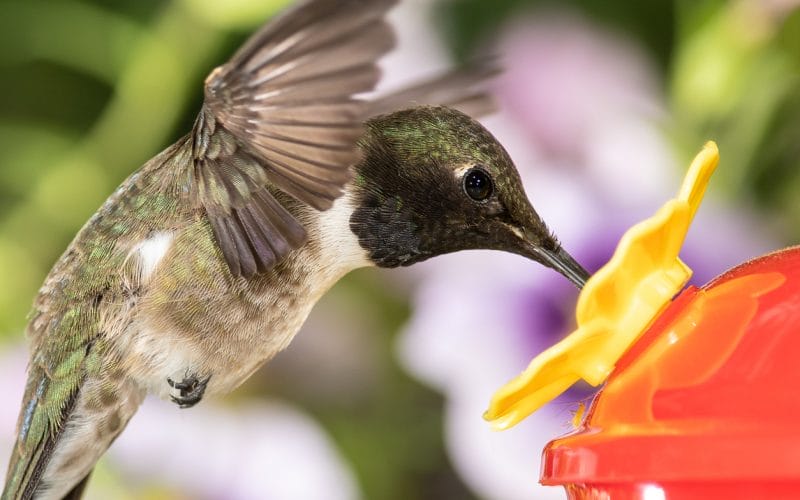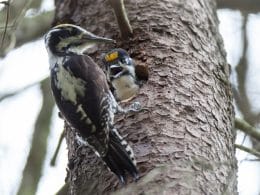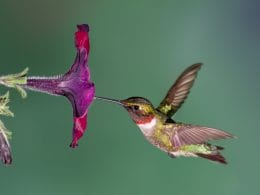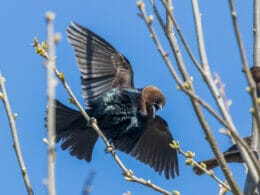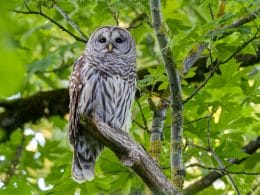Hummingbirds are tiny, but strong. These birds are more commonly found in North and South America, with the latter having the most extensive variety anywhere in the world. In the United States and Canada, about 12 species can be found year-round.
If you’re from Oregon, then this is your lucky day! In this article, we’re taking a look at the seven species of hummingbirds in Oregon.
Let’s get started.
7 Most Common Hummingbirds in Oregon
Hummingbirds belong to the Trochilidae family. They include roughly 330 species of small, brightly colored birds.
These popular backyard birding species are popular not just because of their vivid colors. They’re also famous for their unique flying style. They swoop and dive, with most of them executing a shuttle show, which is a low back-and-forth movement.
They collect and devour insects with the help of their wings. Their primary source of nutrition is nectar from flowers. Because of their small stature and high metabolism, they need to eat regularly throughout the day.
1. Anna’s Hummingbird
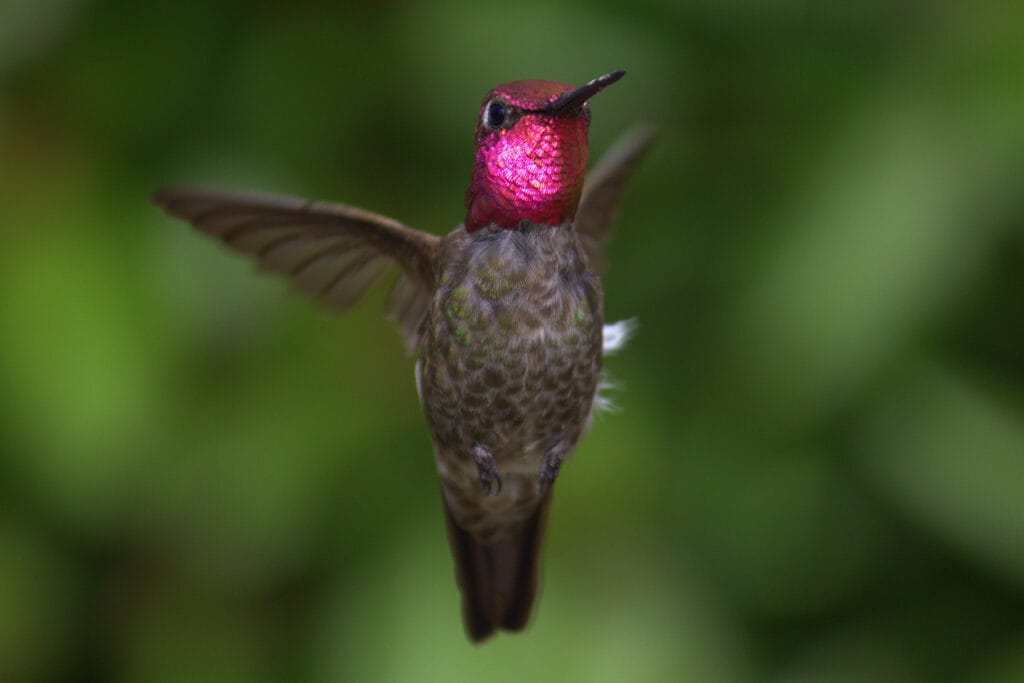
- Scientific name: Calypte Anna
- Length: 3.9 inches
- Weight: 0.1 to 0.2 ounces
- Wingspan: 4.7 inches
Anna’s Hummingbirds are small yet stocky with medium-sized tails. Their plumage is covered in a green and gray hue. The male’s head and throat are iridescent reddish-pink, whereas the female’s throat is gray with hints of red spotting.
Their feathers are a slightly brighter and iridescent green than most other birds. They have a long, thin, and straight bill for sipping nectar, along with their tongues.
Author Note: Anna’s Hummingbirds can be found along North America’s Pacific Coast, but only as far inland as Central Oregon. Anna’s hummingbirds are year-round residents of Oregon. So, you’ll definitely spot them fluttering around.
They’re unique in how they don’t migrate, yet some will move around short distances during the winter. Hummingbirds are also amazing because, during courting, the males climb up to 130 feet in the air before falling back to the earth with a burst of noise from their tail feathers.
Those pretty birds are also famous for their loud voices, accompanied by a metallic, buzzy melody that captivates audiences. In addition, the males produce a series of complicated scratchy noises while they feed or mark territories.
Their song is pretty long compared to other species. It usually lasts ten seconds or longer and consists of a succession of buzzes, followed by a pleasant-sounding whistle. The whole performance can last up to ten seconds and usually ends with some chip notes.
They’re notorious for their highly protective nature and violent temperament. This comes across clearly when anyone or anything tries to come near their nests.
Anna’s Hummingbirds build their nests in trees ranging in height from 6 to 20 feet, and they normally have two to three broods each year.
This species can be found in a variety of environments, including backyards and parks, where huge colorful blooms and nectar feeders can be found. In addition, you can spot them in open forests, parks, and near bodies of water.
2. Allen’s Hummingbird

- Scientific name: Selasphorus Sasin
- Length: 3.5 inches
- Weight: 0.1 ounces
- Wingspan: 4.3 inches
Allen’s Hummingbirds have been spotted as far north as Kings Valley and as far south as Greenberry. They’re also quite popular in the east near Lewisburg and Kiger Island, as well as in the west in the McDonald-Dunn Forest.
In the limited tract of coastal forest and scrub that runs between California and Oregon, Allen’s Hummingbirds can be difficult to tell apart from Rufous Hummingbirds because of their similar coloring.
Male Allen’s Hummingbirds have vivid reddish-orange throats, as well as orange bellies, tails, and eye patches. Both males and females have long, straight bills and coppery-green backs. Yet, females lack bright coloring in the throat area.
Their females have up to three broods every year and build nests at no fixed height along shaded streams.
This species of hummingbirds flutter from one flower to the next, ticking as it eats nectar. It’s also known for its ability to catch insects in the air.
3. Calliope Hummingbird

- Scientific name: Selasphorus Calliope
- Length: 3.1 to 3.5 inches
- Weight: 0.1 ounces
- Wingspan: 4.1 to 4.3 inches
Calliope Hummingbirds are named after Calliope, the Greek mythological muse of eloquence and epic poetry.
Calliope Hummingbirds have been spotted in Oregon’s central region, as well as north on the Washington border down to California. Unfortunately, the number of sightings along the Oregon coast has decreased dramatically in recent years.
The Calliope Hummingbird is about the size of a ping-pong ball. This makes it the tiniest bird in the United States. Still, it manages to fly more than 5000 miles from Mexico to Canada and back each year.
Top Tip: From March through October, Calliope Hummingbirds breed in Oregon and can be observed all around the state. They’re most common from mid-April to mid-August, though.
Male Calliope Hummingbirds have bright magenta gorgets, gleaming green plumage with a black tail. Males of this species are aggressive and spend a lot of time on a high perch watching over their territory.
As a matter of fact, Calliope Hummingbirds can get extremely territorial, despite their tiny size. They won’t hesitate to attack much larger birds, including Red-tailed Hawks, to defend their homes.
The males have a unique courtship display in which he flaps his wings at a frequency similar to that of a bee. Flapping different feathers transmits different messages hoping to attract the female. They can also be seen doing unique U-shaped dives and other flying acrobatics in order to impress females.
Females lack the iridescent throats of males, and their underbelly is pinkish-white instead of white. They usually build their nests in evergreen trees. Yet, sometimes, they reuse old nests or just build on top of existing ones.
4. Rufous Hummingbird
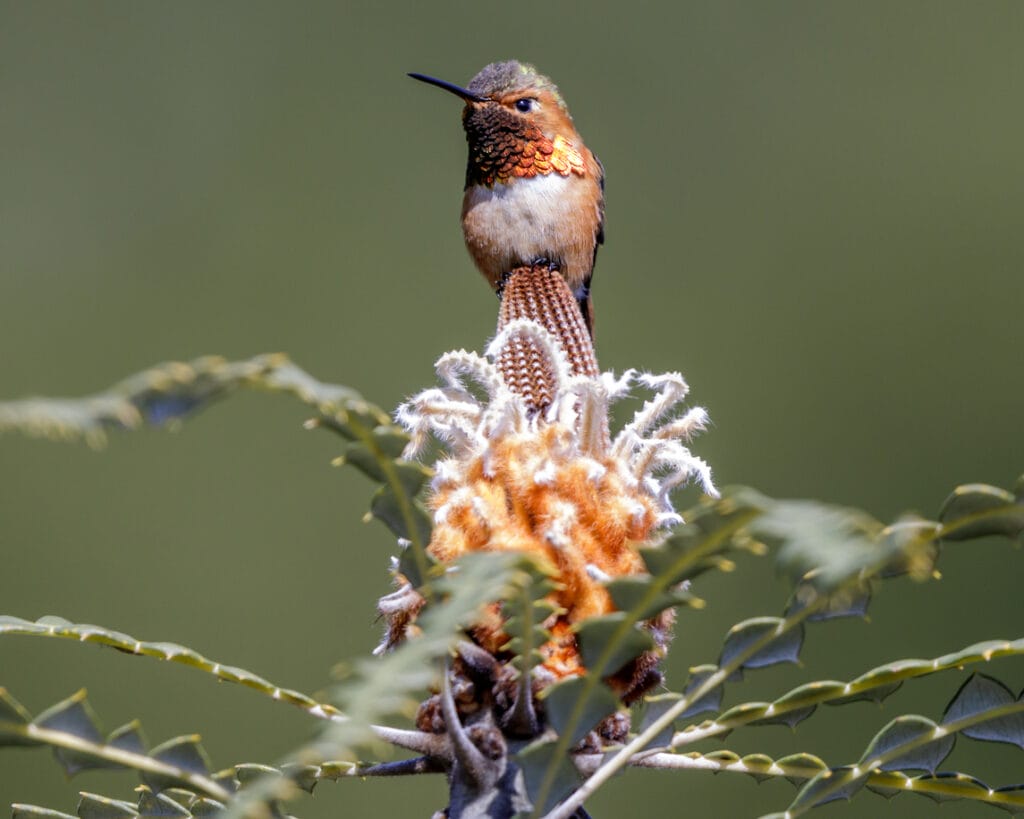
- Scientific name: Selasphorus Rufus
- Length: 2.8 to 3.5 inches
- Weight: 0.1 to 0.2 ounces
- Wingspan: 4.3 inches
This hummingbird species is slender and small, with straight beaks and short wings that don’t reach the ends of their tail when perched.
The Rufous Hummingbird seems to be a very tough species. They can get a little aggressive when they have to share feeders or chase away other hummingbirds.
There have been documented sightings of Rufous Hummingbirds across the whole state of Oregon. Yet, the densest populations can be found in the western half of the state.
Hummingbirds collect and devour insects with the help of their wings. Their primary source of nutrition is nectar from flowers. Because of their small stature and high metabolism, they need to eat regularly throughout the day.
Top Tip: To save energy, they go into a dormant state at night. They can also out-fly any other hummingbird species and are the most maneuverable hummingbird.
Rufous Hummingbirds are one of the world’s longest-distance migrators, flying up to 4000 miles. They migrate north along the Pacific Coast in the spring, then north across the Rocky Mountains in the late summer and fall.
Male Rufous Hummingbirds have a white patch on the upper breast and an orange-red throat.
They tend to be more aggressive than their female counterparts. Not only that, but they can also be hostile to other hummingbirds that they come across during migration, including larger hummingbirds and resident hummingbirds.
Males can get so aggressive to the point of chasing away the females from food sources. They’re also known to take on males from their species and other species as well, even those double their size.
Females differ from males because they have a white belly and are greenish-brown on the back and rusty on the sides. To build their nests, they use soft plants and spider webs. They lay 2 to 3 little white eggs, each measuring about 0.5 inches in length.
5. Broad-Tailed Hummingbird
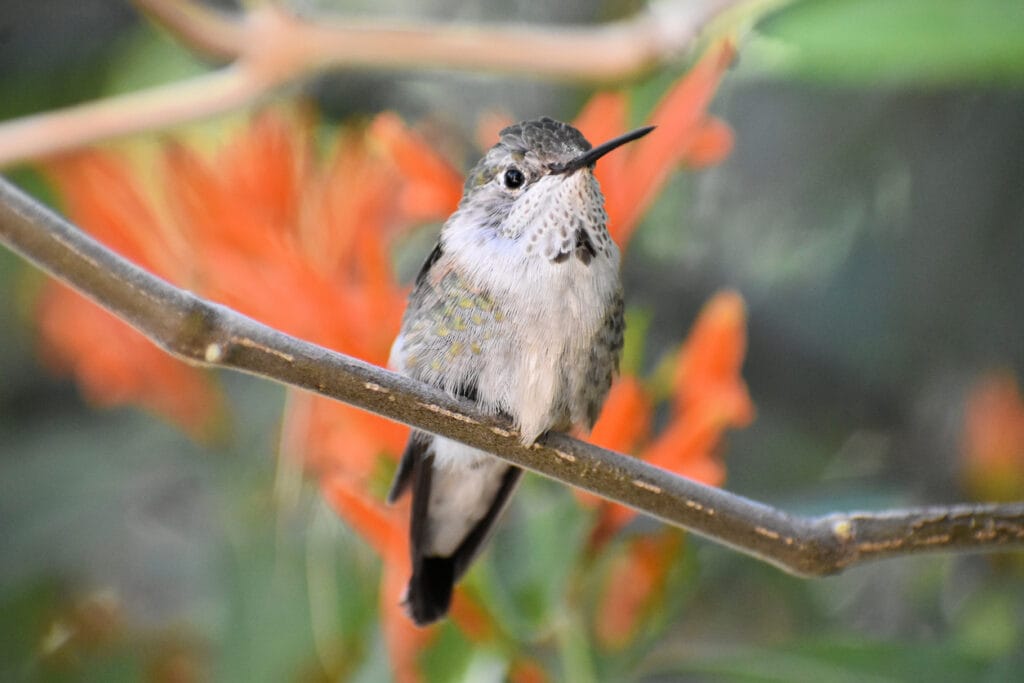
- Scientific name: Selasphorus Platycercus
- Length: 3.1 to 3.5 inches
- Weight: 0.1 to 0.2 ounces
- Wingspan: 5.25 inches
The Broad-tailed Hummingbird sets up its home in the mountains of the northeast and southeast of Oregon.
Broad-tailed Hummingbirds are somewhat rare in Oregon, yet they’re not included on state checklists by chance. However, during the summer, they’ve been seen in the southeast of the state, particularly at Steens Mountain.
Higher elevations are a typical home for the Broad-tailed Hummingbirds. As a result, they can lower their body temperature and reduce their heart rate to enter a state called torpor.
The iridescent, rose-red throats, white chest feathers, metallic green back and crown, and rounded tails of males make them instantly identifiable. In flying, the males’ tails emit whistling sounds.
Females lack the male’s colorful neck patch and are generally pale underneath. Their outer tail feathers, which have a white tip, are rust-colored near the body and blackish in the center.
Broad-tailed Hummingbirds use red columbine, sage, and scarlet gilia, as well as hummingbird feeders. They also eat tiny insects and feed them to their young.
Broad-tailed Hummingbirds make their nests using spider webs and gossamer. They choose hidden spots, like overhanging branches. They also provide increased insulation during chilly nights.
The Broad-Tailed Hummingbird breeds from Wyoming and central Idaho all the way down to Mexico. Their presence during winters in Mexico is infrequent, especially in the Gulf of Mexico states, because they prefer nesting in mountain forests and woodlands.
6. Costa’s Hummingbird

- Scientific name: Calypte Costae
- Length: 3.5 inches
- Weight: 0.1 ounces
- Wingspan: 4.5 inches
They’re considered rare visitors to Oregon. Costa’s Hummingbirds are primarily desert hummingbirds with a purple crown and beautiful iridescent purple throat patches that flare out. Their bellies are white with green coloring on the sides and backs.
Because they resemble several other hummingbird species, many Costa’s Hummingbirds go unnoticed. However, adult males with the mustache-looking gorget are nearly impossible to miss.
Top Tip: The crown and back of the female are grayish-green. Aside from some black markings on the throat, chin, and tail, the underparts are all pale in color.
They build their nests in bushes three to seven feet above the ground, and they can have up to two broods per year.
7. Black-chinned Hummingbird

- Scientific name: Archilochus Alexandri
- Length: 3.5 inches
- Weight: 0.1 to 0.2 ounces
- Wingspan: 4.3 inches
These migratory birds usually arrive in the state between May and October, with some arriving as early as March. They devour nectar, tiny insects, and spiders, and when feeding on nectar, their tongues can lick from 13 to 17 times per second.
Male hummingbirds are medium-sized, with a metallic green body, white breast, and greenish flanks. Their general appearance is black, but their crown is a dark green, and their lower throat is an iridescent violet. They also have a white patch surrounding their eyes.
Females have a greenish-gray cap and back, whereas their chests are white. Similar to the males, they also have a white patch behind their eyes.
Author Note: During the summer, black-chinned hummingbirds breed in Oregon. Then, they move to Mexico for the winter.
This hummingbird is one of the most adaptable of all hummingbird species, living in a variety of settings. Mountain and alpine meadows, canyons with thickets, orchards, urban areas, and newly disturbed landscapes are all ideal places to look for them.
If there are any Black-chinned Hummingbirds in your area, you’ll easily be able to identify them by the sound their wings make, which resembles the hum of a bee. They also produce a variety of different high-pitched ticks and chips when feeding.
To Conclude
Hummingbirds are fascinating species to listen to and observe. They’re also quite amusing, especially when you recognize what hummingbird species you have lurking in your backyard.
Hopefully, this article has shed some light on which hummingbirds in Oregon you can keep an eye out for. By getting to know their size, color pattern, and flying style, you can easily identify each species.
Then, you can decide which one is your favorite!
FAQ
To find out where recent sightings of hummingbirds have been, try eBird. You can search for the latest sightings or particular species or what has been seen in a certain area.
The Rufous Hummingbird is the most common species in Oregon.
The William L. Finley National Wildlife Refuge and Indian Ford Campground are good spots for seeing hummingbird species.




